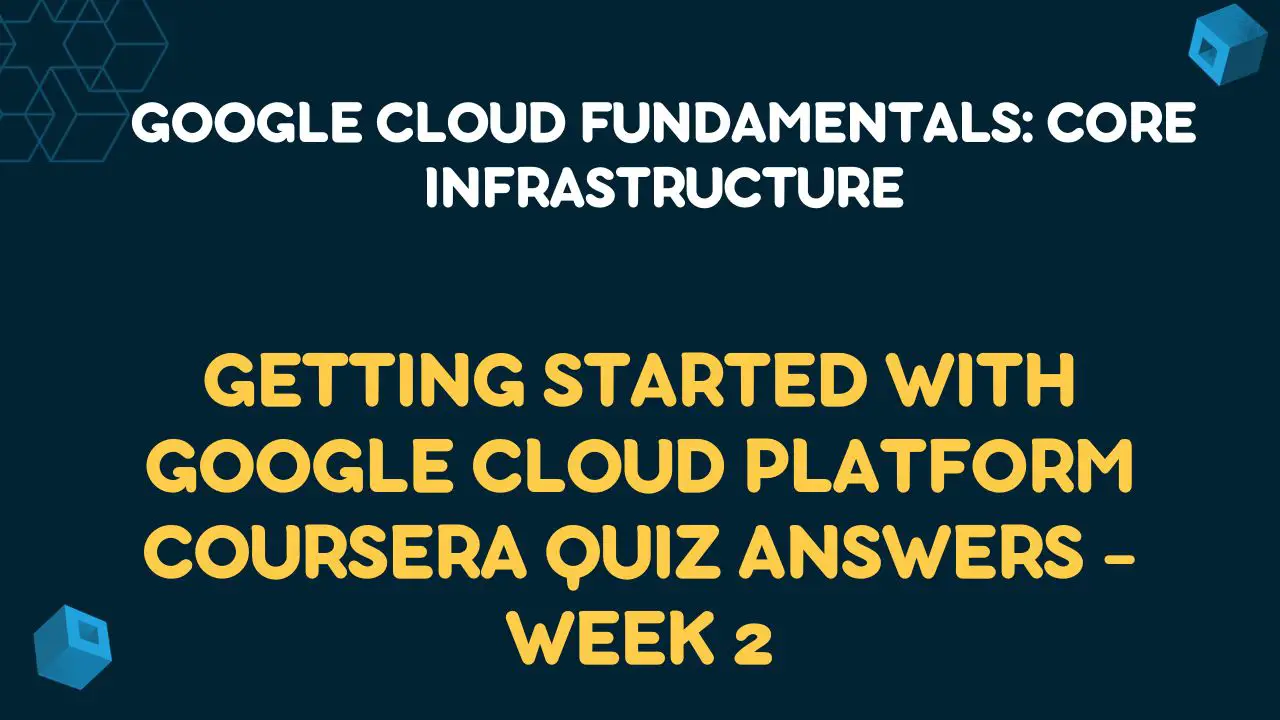Get All Weeks Google Cloud Platform Fundamentals: Core Infrastructure Quiz Answers
Table of Contents
The Google Cloud Platform resource hierarchy
Q1. Choose the correct completion: Services and APIs are enabled on a per__________ basis.
- Billing account
- Organization
- Folder
- Project
Q2. True or false: Google manages every aspect of Google Cloud Platform customers’ security.
- True
- False
Q3. Your company has two GCP projects, and you want them to share policies. What is the less error-prone way to set this up?
- Duplicate all the policies on one project onto the other.
- Place both projects into a folder, and define the policies on the folder.
Resources and IAM
Q1. When would you choose to have an organization node? (Choose all that are correct. Choose 2 responses.)
- When you want to create folders.
- When you want to organize resources into projects.
- When you want to apply organization-wide policies centrally.
- There is no choice; organization nodes are mandatory.
Q2. Order these IAM role types from broadest to finest-grained.
- Primitive roles, predefined roles, custom roles
- Custom roles, predefined roles, primitive roles
- Predefined roles, custom roles, primitive roles
Q3. Can IAM policies that are implemented higher in the resource hierarchy take away access that is granted by lower-level policies?
- Yes
- No
Getting Started with Google Cloud Platform
Q1. True or False: In Google Cloud IAM: if a policy applied at the project level gives you Owner permissions, your access to an individual resource in that project might be restricted to View permission if someone applies a more restrictive policy directly to that resource.
- True
- False
Q2. True or False: All Google Cloud Platform resources are associated with a project.
- True
- False
Q3. Service accounts are used to provide which of the following? (Choose all that are correct. Choose 3 responses.)
- A way to allow users to act with service account permissions
- Authentication between Google Cloud Platform services
- A way to restrict the actions a resource (such as a VM) can perform
- A set of predefined permissions
Q4. How do GCP customers and Google Cloud Platform divide responsibility for security?
- All aspects of security are the customer’s responsibility.
- Google takes care of the higher parts of the stack, and customers are responsible for the lower parts.
- All aspects of security are Google’s responsibility.
- Google takes care of the lower parts of the stack, and customers are responsible for the higher parts.
Q5. Which of these values is globally unique, permanent, and unchangeable, but chosen by the customer?
- The project’s billing credit-card number
- The project ID
- The project number
- The project name
Q6. Consider a single hierarchy of GCP resources. Which of these situations is possible? (Choose all that are correct. Choose 3 responses.)
- There are two or more organization nodes
- There is no organization node, and there are no folders.
- There is an organization node, and there are no folders.
- There is an organization node, and there is at least one folder.
- There is no organization node, but there is at least one folder.
Q7. What is the difference between IAM primitive roles and IAM predefined roles?
- Primitive roles can only be granted to single users. Predefined roles can be associated with a group.
- Primitive roles are changeable once assigned. Predefined roles can never be changed.
- Primitive roles only apply to the owner of the GCP project. Predefined roles can be associated with any user.
- Primitive roles affect all resources in a GCP project. Predefined roles apply to a particular service in a project.
- Primitive roles only allow viewing, creating, and deleting resources. Predefined roles allow any modification.
Q8. Which statement is true about billing for solutions deployed using Cloud Marketplace (formerly known as Cloud Launcher)?
- You pay only for the underlying GCP resources you use, with the possible addition of extra fees for commercially licensed software.
- You pay only for the underlying GCP resources you use; Google pays the license fees for commercially licensed software.
- Cloud Marketplace solutions are always free.
- After a trial period, each Cloud Marketplace solution assesses a fixed recurring monthly fee.
All Google Cloud Platform Fundamentals: Core Infrastructure Quiz Answers
Week 01: Introducing Google Cloud Platform
Week 02: Getting Started with Google Cloud Platform
Week 03: Virtual Machines in the Cloud
Week 05: Containers in the Cloud
Week 06: Applications in the Cloud
Week 07: Developing and Monitoring in the Cloud
Week 08: Big Data and Machine Learning




